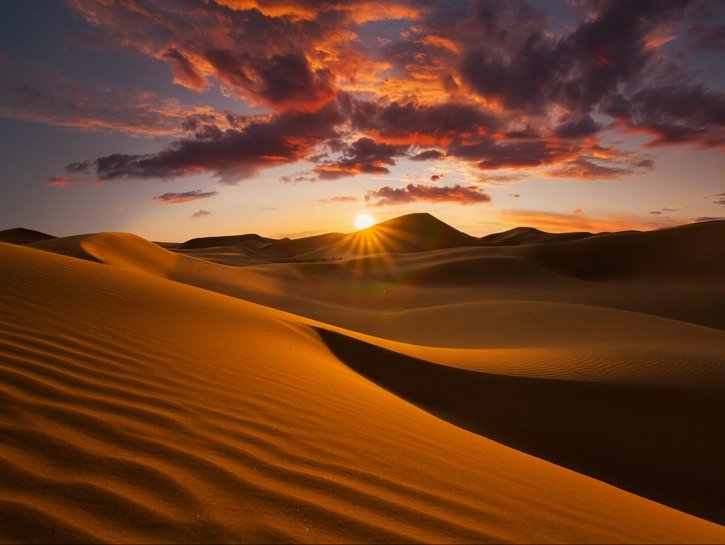
When you tell your friends you’re planning a vacation to the Sahara Desert, don’t be surprised if they respond, simply, “Why?”
Videos by TravelAwaits
It’s a fair question. The Sahara is one of the world’s largest deserts. It’s nearly devoid of life-giving rainfall, and it’s considered one of the toughest places on earth for life of any kind.
Lots of people would say that makes it a questionable spot to take a vacation — but those people would be…misguided. In fact, the Sahara offers the adventure of a lifetime to travelers of all persuasions. You can even explore the area in plush comfort if you know where to look.
Whether it’s been on your bucket list for years or you’re just in the mood for something completely different, the Sahara Desert may be your next favorite vacation destination, or at least the most memorable. Here’s what you need to know to get the most out of your trip to the King of Deserts.

Where Exactly Is The Sahara Desert?
Short answer: The Sahara is in Africa. But as we mentioned, the Sahara is the largest desert in the world, outside of the polar areas. Covering almost one third of the African continent and spanning over 3.6 million square miles, this desert is a vast tranquil ocean of sand — and so much more.
Scientists divide the desert into six distinct ecoregions, each with its own system of plant and animal life. In that sense, then, there isn’t just one Sahara Desert. There are many Saharas. And not all of them are equally great for a vacation.
Likewise, not all of them are in a single country. Most North African nations, including Algeria, Morocco, Egypt, and northern Niger (which is not technically a North African nation, but that just goes to show how huge the Sahara really is), encompass some of this enormous region. While some parts of the desert are off limits, there are still plenty of places to safely experience the beauty of this natural wonderland.
In fact, the only areas you should typically avoid are those restricted due to civil and political unrest. You’ll be safe as long as you follow specific guidelines for entry into and passage through the desert. You can (and should) always check the U.S. State Department’s website for detailed information about security concerns for any country you plan to visit.
But for now, let’s focus on the two Sahara-access countries that U.S. travelers tend to favor, both for the bustling tourism infrastructures already in place and for the incredible food, lodgings, services, and experiences that await visitors there: Morocco and Egypt.
How To Get To The Sahara Desert Through Morocco
Morocco is probably the most popular destination for access to the Sahara. As of this writing, Royal Air Maroc is the only airline that offers direct flights from the United States. You can also fly Delta, Air France, American, Qatar Airways, Lufthansa, Turkish Airlines, Norwegian, Air Europa, or Condor — if you don’t mind layovers.
A direct flight from New York to Marrakech airport takes about nine hours, whereas flights with international stops will require at least 11 hours of travel. Some of these flights can take over 20 hours with layovers factored in. Of course, that may be well worth it if you catch a cheap fare.
Whatever airline you choose, fly into the Moroccan city of Marrakech. This will put you within reach of the most popular Sahara attractions without having to travel too far by land. Once you’re in the region, of course, you’ll need to get out of the city and into the desert.

Morocco has a great bus system that can take you into the Sahara. The two main bus companies are Supratours and CTM. Currently, Supratours is the only one offering direct rides to one of the most popular desert city destinations, Merzouga.
If you want to get to Merzouga as quickly as possible, the 12-hour Supratour bus ride is the best option. Or you can break up the trip into multi-night stops to experience more of the area.
Cities like Ouarzazate, Ait Benhaddou, and Dades Gorge all have beautiful sites, museums, tours, and restaurants worth checking out. Why not make your Saharan vacation into a complete tour of the settled region?
How To Get To The Sahara Desert Through Egypt
Another option for visiting the Sahara is to travel through Egypt. From the United States, you can fly directly into Cairo via EgyptAir flights, or you can use Lufthansa, Emirates, Delta, American, United, or Air France for flights that stop here and there in other countries. A direct flight from New York will take about 10 hours and 30 minutes, whereas flights with even just one stop range from 13 to 25 hours of travel time.

Once you arrive in Cairo, you have a few options for Saharan adventure, all of which are located in the western portion of the country. There are direct bus lines from Cairo to multiple desert oases, such as Siwa, Al Kharga, Dakhla, Farafra, Bahariya, and the White and Black Deserts.
It’s possible to plan your entire Saharan trip yourself, but why bother, when there are so many excellent and reasonably priced organized tours? If relying on busses and taxis, negotiating ride fares, and booking your own hotels sounds too overwhelming, a tour might be the way to go.
When Is The Best Time To Visit The Sahara?
There are lots of factors to take into consideration when deciding on the time of year to visit the Sahara Desert. Of course, you should start by thinking about that desert heat. The Sahara is at its hottest between June and September, so if you’re not a fan of sunscreen and extra water bottles, avoid this season.
But that doesn’t mean you should restrict travel to the winter months. From November through February, daytime temperatures are mild—but once the sun sets, temperatures plummet, sometimes even below freezing. Dust storms are prevalent from February to April. All that considered, the landscape is seemingly at its most pleasant from March through May and September through October.
Sahara Desert Luggage Essentials
When packing for your trip, consider the activities you have planned. Will you ride camels through the desert? Camp under the stars? Or will you relax in a luxurious resort while taking brief day trips into the wilderness beyond the city?
Generally speaking, there are a few items every Sahara visitor should include in their checked luggage. For instance, be sure to pack long, comfortable pants for walking and leg protection when riding camels. Bring a light jacket, a hat, and a scarf to wrap around your head and face for protection from blowing sand and sun.
And don’t forget sunscreen. Bring your favorite comfortable sneakers, hiking boots, or hiking sandals. Finally, you’ll definitely want a camera and extra batteries — plus a brush to clear sand off the camera lens.

Activities And Attractions In The Sahara Desert
The Sahara Desert is full of beautiful ancient ruins, sand dunes as tall as mountains, and wondrous oasis towns. You can ride a camel, camp outside under the desert night sky, watch wildlife at play, or even have a desert spa experience.
Whatever your interests, this sparse environment is packed with lush opportunities. Here are just a few of them to get you started:
The Majorelle Gardens
If you fly into Marrakech, Morocco, be sure to visit the Majorelle Gardens before leaving on your desert quest. French painter Jacques Majorelle spent 40 years perfecting this little oasis in the city. The grounds are filled with banana trees, palms, marble pools, water channels, and fountains with pathways woven throughout. There’s also a Berber culture museum on the grounds that’s not to be missed.
The gardens and museum are open every day, from 8 a.m. to 5:30 p.m. between October 1 and April 30. They’re open from 8 a.m. to 6 p.m. between May 1 and September 30. And they’re open from 9 a.m. to 5 p.m. during the month of Ramadan. Admission costs around $20 for the gardens and $10 for the museum.

Erg Chebbi
Located just two days by car from Marrakech, Erg Chebbi is an easily accessible, tourist-ready section of the Sahara that hasn’t sacrificed a bit of its natural, wind-swept grandeur. An erg is the desert as it exists in your imagination: sand, sky, and dunes as far as the eye can see.
What makes Erg Chebbi so special is the wealth of experiences available to visitors. Located so close to the city, the locals have had plenty of time to build a thriving tourism economy.
Take a camel trek across the dunes, or camp in luxury beneath the stars. Stop in a Berber village and watch the sun set over the sand. If you want to experience the pure, sandy Sahara, Erg Chebbi is a great choice.

Siwa
Siwa is a true Egyptian oasis area on the western edge of the nation. The desert gives way to green olive groves and, seemingly out of nowhere, water. Siwa is ripe with mineral springs, salt lakes, and swimming pools — including Cleopatra’s Pool, where the Ptolemaic ruler is said to have soaked herself more than 1,000 years ago.
Stop in the Siwa town of Shali to tour the ancient ruins of the Shali Fortress. Trace the footsteps of Alexander the Great to find the historical site of the Oracle of Siwa. Experience desert beauty, startling history, and luxury comforts here and all over the Sahara.
Just be sure to take lots of pictures. They’re the best answer to your friends’ doubtful question: “Why?”
Photo Credit: Anton Petrus / Shutterstock, Patrick Poendl / Shutterstock

